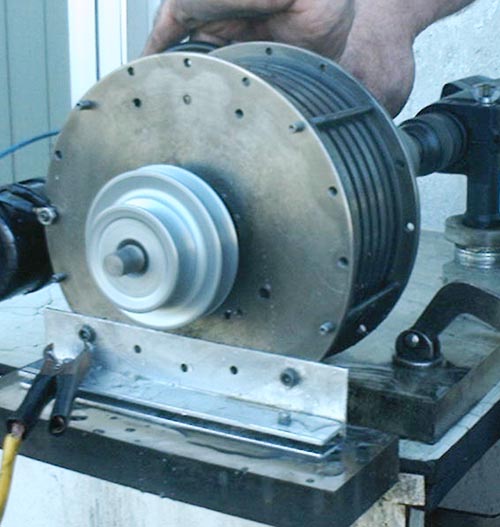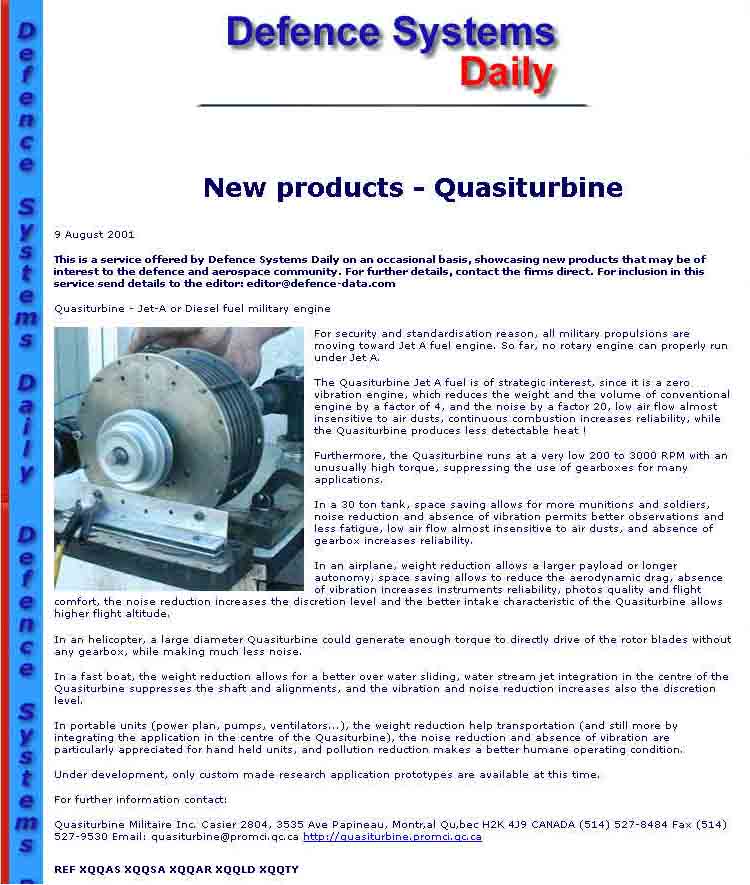Quasiturbine
Jet-A or Diesel fuel military engine
... even more that jet or Diesel...
With a potential of 10 HP per pounds or more in pneumatic or steam mode,
the Quasiturbine is an exceptional candidate for the marine supercavitating vehicles burning metal fuels (aluminium, magnesium or lithium)
http://www.sciam.com/2001/0501issue/0501ashley.html
Aluminium is the most energetic of these metal fuels, producing a reaction temperature of up to 10,600 degrees Celsius.
One can accelerate the reaction by fluidizing the metal and using water vapor.
The heat from the combustion chamber would be used to melt stored aluminium sheets at about 675 degrees C and to vaporize
water as well.
High-pressure steam from this combustion process expands out to drive a Quasiturbine
(?) that turns a propeller screw.
This would be an extremely high power density aluminium-burning "water ramjet"
system.
The Quasiturbine theory analyses and optimizes 14 different engine parameters (see the book).
For security and standardization
reason, all military propulsions are moving toward Jet A fuel engine.
So far, no rotary engine can properly run under Jet A.
The Quasiturbine Jet A fuel is of
strategic interest, since it is a :
zero vibration engine,
which reduces the weight and the volume of conventional engine by a factor of
4,
and the noise by a factor 20,
low air flow almost
insensitive to air dusts,
continuous combustion increases reliability,
while the Quasiturbine produces less detectable heat !
Possible zero EMF
(Electro-Magnetic Field) engine operation.
Furthermore, the Quasiturbine runs
at a very low 200 to
3000 RPM (meaning a very long engine live time)
with an unusually high torque,
suppressing the use of gearboxes for many applications.
Due to steep pressure rise in the Quasiturbine,
the use of synchronized conventional injectors may not be necessary for some
applications.
Submersible without crankcase nor electrical circuit.
Hybrid Quasiturbine-Fan (or Quasiturbine-Jet)
No temperature limit in the jet nozzle!
Considering the high power density, the
low cross section area and the exceptional intake characteristics of the
Quasiturbine,
it is reasonable to expect to conceive an airplane engine:
1) Quasiturbine-Fan
in which the Fan would be driven by a Quasiturbine,
rather that by a conventional power turbine.
2) Quasiturbine-Fan Hybrid
in which only the compressor would be driven by a Quasiturbine,
leaving all the reactor energy available to drive a still more powerful Fan.
The Quasiturbine air intake could come from the compressor.
The empty center of the Quasiturbine would allow the shaft to go from the
power turbine to the fan.
3) Quasiturbine-Jet reactor (no hot turbine)
Still more revolutionary would be a Jet Reactor without power
turbine in the hot gas flow,
where the compressor would be driven by a Quasiturbine, leaving to the Jet all
its propulsive energy.
The Quasiturbine air intake could come from the compressor.
In this last case, the suppression of the
conventional power turbine
would permit to operate the engine at much higher temperature without risking to
melt the non-existent power turbine,
and would permit to substantially increase the speed and the efficiency.
This airplane engine would operate in the same mode as the rocket engines!
For still a higher power density,
the Quasiturbine could be fuelled in pneumatic mode in hydrogen peroxide.
Those concepts would also permit to construct much
less complicated airplane engines
and at a much lower cost than conventional turbines.
More at : http://quasiturbine.promci.qc.ca/QTAviation.html
Quasiturbine-Stirling Engine
Silent, zero-vibration, and little pollution
http://quasiturbine.promci.qc.ca/QTStirling.html

Various military applications
In a 30 tons tank, space saving
allows for more munitions and soldiers,
noise reduction and absence of vibration permits better observations and less
fatigue,
low air flow almost insensitive to
air dusts,
and absence of gearbox increases reliability.
In a propeller airplane, weight reduction
allows a larger payload or longer autonomy,
space saving allows to reduce the aerodynamic drag,
absence of vibration increases instruments reliability, photos quality and
flight comfort,
the noise reduction increases the discretion level,
the high torque allows the use of multi-blades propeller
and the better intake characteristic of the Quasiturbine allows higher flight
altitude.
The hybrid Quasiturbine-Fan (or Quasiturbine- Jet) engine
would be more powerful and efficient.
See: http://quasiturbine.promci.qc.ca/QTAviation.html
In an helicopter, a large diameter
Quasiturbine could generate enough torque
to directly drive of the rotor blades without any gearbox, while making much less noise.
The weight reduction of any equipment using a Quasiturbine make it more
suitable for helicopter transportation.
In a fast boat, the weight reduction allows for a better
over water surfing,
water stream jet integration in the center of the submersible Quasiturbine suppresses the
shaft and alignments,
and the vibration and noise reduction increases also the discretion level.
Outboard marine submersible Quasiturbine can also be of great interest.
In a pneumatic sub-marine,
everything is outside the habitacle:
the air tanks are underneath as emergency lest,
the Quasiturbine submersible jet propulsion is remote behind,
and the Quasiturbine air exhaust is feed inside and respirated by the crew!
In a nuclear sub-marine, a steam
Quasiturbine
http://quasiturbine.promci.qc.ca/QTVapeur.html
would produce the necessary torque to directly drive the propeller shaft
without delay in both directions (reversing the flow),
and would allow for a complete and quite stop.
In a torpedo, a 1000
hp hydrogen peroxide fueled Quasiturbine would be more compact and lighter,
with a larger range, and producing an efficient multi-power level output (which
conventional turbine can not allows).
In terrestrial multi-wheels
drive vehicles, independent pneumatic or hydraulic Quasiturbines
can be all
connected to one central pressure distribution point
such as to generate equal torque
independently from the individual RPM.
Torque modulation can further provide the vehicle direction control.
In portable units (power plan, pumps,
ventilators...),
the weight reduction help transportation (and still more by integrating the
application in the center of the Quasiturbine),
the noise reduction and absence of vibration are particularly appreciated for
hand held units,
and pollution reduction makes a better humane operating condition.
In precision guided device,
the low harmonic Quasiturbine engine
permits a precise RPM, power and acceleration control over a wider
range.
For zero
EMF (Electro-Magnetic Field) engine operation,
the Quasiturbine offers 5 modes: pneumatic, steam,
continuous combustion, diesel and photo-detonation.
For stealth
operation, a plastic made Quasiturbine is radar
undetected
with a noise 20 time less than the conventional engine,
and in pneumatic mode, the exhaust can be near ambient temperature, with
zero EMF.
In rockets, the
Quasiturbines Pumps and Turbo-pumps would permit
a better control of fuel injection http://quasiturbine.promci.qc.ca/QTPompe.html
Prototypes in development,
only RESEARCH APPLICATION PROTOTYPES
are custom made available at this time.
Published by Defence Systems Daily at : http://defence-data.com/current/page11838.htm (expired)

* * * * *
Quasiturbine and the Future of Deployment and
Sustainment
By Scott Miller
Lugnut4325@aol.com Juine 2003
Dominant Logistics
http://www.geocities.com/dominantlogistics
See the reference to Quasiturbine at : Future Combat
Vessels
http://www.geocities.com/dominantlogistics/fcv.html
SWATH Aircraft and Cargo Carriers ...
A new type of engine can power this vessel
offering some significant advantages over current powerplants.
We still want the
range and power advantages of nuclear power but we should replace the steam
turbines with Quasiturbines
for tremendous reductions in maintenance and
operations costs quasiturbine.promci.qc.ca
.
Nuclear power uses steam to drive turbines but the temperature of the steam is
relatively low and this causes fouling problems with the turbine.
The
Quasiturbine is more resistant to fouling, uses fewer parts, and can have
electrical generation hardware
integrated into the engine for reductions in size
and weight as well.
The Quasiturbine could also be physically coupled to
propellers or waterjets.
While Quasiturbines can be steam driven, they can also
run from fuel combustion as well and can run on virtually any fuel, just like
traditional turbines.
What this means is that the same engine can be utilized to
power all of our large Navy vessels and submarines
- we only need to vary the
quantity of engines used to the application. This should streamline our support
and training needs considerably...
The Quasiturbine is a technology listed by par INIS © International Atomic Energy Agency,
Wagramer Straße 5
P.O.Box 100 A-1400 Vienna AUSTRIA
http://www.iaea.or.at/programmes/inis/ws/d2/r1785.html
* * * * *
Comment on Nuclear Navy Fleet with hydrogen
production facility
by Cyril Meynier meynier.cyril@wanadoo.fr
03.10.04
Today, a fleet (say a US NAVY Task Force) is vulnerable because of the need of
tankers for refuelling.
Tankers are slow, and are easy targets. Only the aircraft carrier and the
submarines are nuclear powered and, therefore, autonomous for years.
Other ships, like cruisers, frigates, mine warware ships, needs oil-derivated
products, as well as for helicopters and fighter jets.
Now, gives the aircraft carrier three fourth generation, plutonium-fed high
temperature nuclear reactors,
each able to produced electric power for propulsion and, using thermo chemical
reactions, to produced hydrogen from seawater.
Indicative figures :
- Each reactor gives 180 Mw of thermal power.
- It is cooled by helium that produces 60 Mw of electric power used to propel
the ship (efficiency : 30%).
- The remaining heat is used for thermo chemical hydrogen production, with 50%
efficiency,
so "60 Mw of hydrogen" are produced by each reactor. It's to say, 1 kg every two
seconds. It's to say, 43.2 metric tons per day.
Now let's the fleet have six such reactors : three for the carrier, two on
submarines, one on an escort cruiser.
It can produced 260 metric tons of hydrogen per day. This is approximately as
much energy as 900 tons of kerosene of fuel.
When the nuclear-powered ships are not running full speed, you could change the
settings to get less electricity and more hydrogen,
so your task force can be self-sufficient for years. No more slow and vulnerable
oil tanker.
Of course, hydrogen is not suited for military aircrafts, but one can chemically
produce an heavier fuel (like an alcohol)
using hydrogen and CO2 captured from atmosphere.
Hydrogen-fuelled frigate may, imho, have an hybrid propulsion : Fuel cells -
Gas turbines.
The best way would probably be to use FC for baseload power (low speed) and
turbines for high power.
Similarly, many present military ships uses combined diesel engines and gas
turbines. Of course, there are three problems :
1- This imply a totally new fleet, so this is a very long-run view.
2- Transferring hydrogen for one ship to another would be a difficult and
dangerous operation.
3- Nuclear-powered ships would need to carry very large chemical facilities.
The Quasiturbine is an efficient direct hydrogen
combustion engine !
* * * * *
| Return to main menu |
Quasiturbine Militaire Inc.
Casier 2804, 3535 Ave Papineau, Montréal Québec H2K 4J9 CANADA (514) 527-8484 Fax (514)
527-9530
http://quasiturbine.promci.qc.ca
quasiturbine@promci.qc.ca